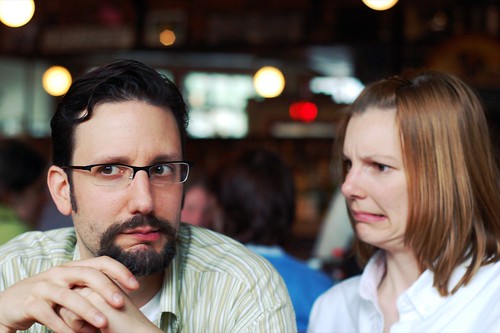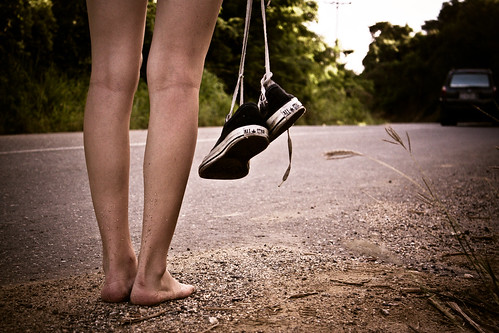I’ve just completed 4 days worth of training on digital storytelling with a handful of colleagues that was run by Alex Henry of Curiosity Creative, formerly of Tyne and Wear Archives and Museums. This is just a brief report written immediately after the event so my thoughts on it aren’t fully formed.
Andy Stewart and I had met Alex at September’s Culture Shock conference and had been planning for a while how we could work together. This was the culmination of all that.
It was a great experience. We were mostly approaching it from the point of view of supporting projects to create digital stories (but not exclusively). Even though I’ve done a fair bit of work around DS in the past this was the first opportunity to really sit down and experience it as an extended facilitated session.
The method Alex was following was based on the one devised by the Centre for Digital Storytelling in the States by Joe Lambert. The aim was to produce a finished digital story but the process of getting to that point was the most interesting bit. I’ve included materials on my own story as a way of illustrating what we did.
Day 1 was about getting comfortable with telling stories to each other and finding ways of bringing stories out of other people. We tried activies like using objects and single pictures to inspire stories, free writing (writing non-stop, even when you’ve got nothing to write about) and sharing these stories with the rest of teh group. The story I eventually produced started off as a free writing exercise.
Then we used Audacity to create a raw, unedited audio file that would form the basis of the final product.
These 2 days were for me the highlight. There was compartively little digital activity which meant we focussed on the creation of the story and seeing storytelling as a social act in a way I hadn’t realised before. A particular discovery for me was realising how important it is to keep the language simple and as authentic as possible. Putting on affectations and purple prose makes the story less engaging (and makes me sound more of a pillock than usual!).
As a group we had discovered quite a lot about each other by the end, very useful as the basis for working together more in the future.
Day 3 took place 3 weeks after the previous day. we used the time between to gather together or creating the images we were going to use which, as ever, I left to the last minute but did mean I spent a large amount of time in the attic with our photo collection, rediscovering lost memories.
The morning of day 3 was devoted to editing the audio we had recorded before the break, mostly a neatening exercise.
The afternoon was probably the most frustrating part of the process. The aim was to have created a rough cut with the sound file and the images all ordered but with no editing or effects. Having felt a certain amount of freedom during the first couple of days I was now trapped by the constraints of iMovie and it all stopped being a social process. We all noted how quite we had become as a group as we got on with constructing our timelines. A few technical glitches meant I left feeling overwhelmed and that I wasn’t adding anything to my story, just over complicating it.
Day 4 – Feeling ill didn’t help with my motivation initially and I was expecting more of the feelings of yesterday afternoon but in the end it worked out OK. My main concern was that the images I had chosen just weren’t right. I was trying to strike a balance between not so literal that the images HAD to be what I was talking about or too abstract. Slowly, though it began to take on more of a shape and despite a few hiccups iMovie seemed to get out of the way more so I could just get on with making the story.
Adding titles, transitions and effects to the images was a fiddle and I was glad I’d done stuff like this in the past or I’d have been tearing my hair out.
I replaced some of the images that weren’t working and it seemed to make more sense. I debated whether or not to add sound effects to certain bits, worried that it might get distracting – I’m still unconvinced by one of them but the sound over the close of the story feels like it works well and has a role in the story.
Am I happy with it? Erm, yes, mostly? I wish I’d made it sound more conversational and less self-consciously “spoken”. I think the images worked well in the end. I’m not sure how I feel about other people seeing it (but I’m still blogging it so I can’t be that worried…).
I think we were all pretty exhausted by the time we came to showcase what we’d produced to each other (and a few invited guests) and I felt a little flat at the end. I loved seeing the other stories and the different approaches we’d all taken and I felt like I should offer more than just applause at the end of each but maybe a mixture of tiredness and that we’d been working so intensely for the day meant it was difficult to think of valuable things to say. That not a reflection on the whole process or the quality of the other stories.
It was importat to experience the whole process as a participant. Without doing this training it would be harder to put myself in the position of someone who is being asked to do this as part of their project. I was surprised by the emotional highs and lows and the impact of the various successes and failures had on me.
This course made me feel vulnerable and exposed, but in a good way (!). We were dealing with personal issues in our stories but just creating something that you have invested time a creativity into that is then shared is uncomfortable and the people we’ll be supporting will feel that too.
Taking it forward
I’m going to spend a bit more time reflecting on this but I want to be able to articulate (and blog about):
- what I learnt about the benefits of telling stories
- how this model of storytelling fits with the work that Netskills and Infonet are doing
- being clear about purpose, audience and impact for JISC funded projects
- how to write better stories.
Thanks to Alex for a great 4 day course and thanks to my co-participants for being supportive, encouraging, constructive and great fun into the bargain!

